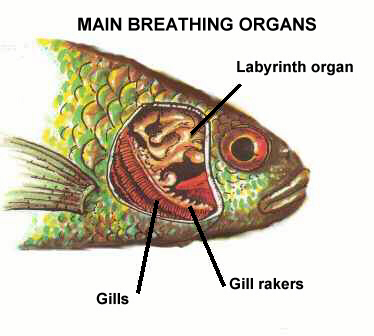| Two Breathing
Organs

DIAG. 3.
Anabantid Breathing
organs
Having two methods of breathing increases the survival
opportunities
for Bettas. It is this organ that enables us to keep Bettas
in small containers.
The labyrinth organ enables Bettas to live in oxygen
depleted waters,
under conditions that would be lethal to most other fishes. The
warm
waters in which Bettas live are often poor in available oxygen.
The labyrinth organ is a wonderful adaptation for
survival that enables
Bettas to extend their habitats into rice paddies and ditches.
|
Bettas are anabantids (of the Family Anabantidae),
being fishs
with an auxiliary breathing apparatus known as the labyrinth organ,
that
enables them to respire by breathing directly from the surface of the
water.
Taking air into their mouths and passing it over the labyrinth organ
and
out of their gill slits supplements the more usual breathing by way of
gills. Other fishes with labyrinth organs include the other Betta
species
and gouramies.
The origin of the scientific name, Anabantidae, derives
from
the Greek verb, anabaino, meaning "to ascend" or "to go up",
referring
to the habit of such fishes as they swimming to the surface to respire.
Back to Profile Page
|